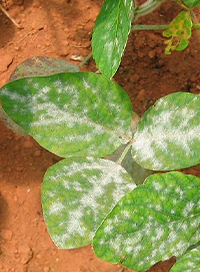 Powdery mildew is a disease that affects a range of plants, including soybeans. In soybeans, this disease is caused by the pathogen Erysiphe diffusa. If weather conditions are favorable for disease development, powdery mildew can reduce the number of soybean bushels in a yield.
Powdery mildew is a disease that affects a range of plants, including soybeans. In soybeans, this disease is caused by the pathogen Erysiphe diffusa. If weather conditions are favorable for disease development, powdery mildew can reduce the number of soybean bushels in a yield.
- Symptoms: Powdery gray or white patches appear on soybean plants. Symptoms are most obvious on upper leaf surfaces.
- Geography: The disease is sometimes found in the midwestern United States. It’s relatively uncommon in the United States.
- Timing: Mid-to-late-summer
- Conditions for development: Cool, cloudy weather with low humidity is optimal. Cool weather late in the growing season increases the risk for development.
- Scouting tips: The disease is most likely to appear during mid-to-late reproductive stages of soybean plants. Pay close attention to scouting during this time. Late-planted beans are at higher risk.
- Effect on yield: The disease can have an adverse affect on yield because it can be harmful to plant development. It can cause defoliation in susceptible varieties of soybeans.
- Management tips: Choose resistant soybean varieties with your retailer and apply a fungicide preventively.
 Powdery mildew is a disease that affects a range of plants, including soybeans. In soybeans, this disease is caused by the pathogen Erysiphe diffusa. If weather conditions are favorable for disease development, powdery mildew can reduce the number of soybean bushels in a yield.
Powdery mildew is a disease that affects a range of plants, including soybeans. In soybeans, this disease is caused by the pathogen Erysiphe diffusa. If weather conditions are favorable for disease development, powdery mildew can reduce the number of soybean bushels in a yield.